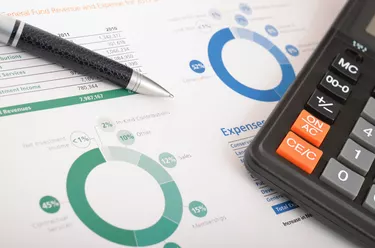
The accounting process consists of a series of tasks often referred to as accounting steps. The process goes through cycles in which the same accounting steps are repeated during each accounting period. Starting with recording business transactions and ending with presenting financial statements, following basic accounting steps can demonstrate the various effects business transactions have on your company's financial position and performance.
Journalizing Transactions
Video of the Day
Companies must record each business transaction in the book of original journal entry, a step referred to as journalizing. Through journalizing, each business transaction is recorded in two related but opposite accounts, with one account debited and the other account credited in the same transaction amount. Generally, journal entries are entered in the order of their transaction dates when transactions occurred.
Video of the Day
Posting to Ledger
Account information recorded in the original journal book must be later transferred and posted to the general ledger. The general ledger has an account format that makes it easier to source account data for financial-statement compilation. A general ledger groups accounts based on the structures of the balance sheet and income statement. All transaction amounts found in the journal for each ledger account are totaled and then shown as the balance of that ledger account.
Preparing Trial Balance
Preparing a trial balance is to have a list of the general ledger accounts with all the debit amounts shown in one column and all the credit amounts in another column. Each column is totaled and their sums are compared to each other to see if there is a balance or any inequality. The purpose of preparing a trial balance is to reveal any journalizing or posting errors from earlier recordings and correct them so that compiling financial statements may proceed.
Making Adjusting Entries
Companies may need to make certain adjusting entries on some business transactions that tend not to be recorded until the end of an accounting period. Such business transactions often include prepayments made by a company as prepaid expense or by customers as pre-sale revenue, as well as any accrued revenues or expenses that are simply not recorded during a period, such as accounts receivable or unpaid salaries. A prepayment adjusting entry appropriately adjusts the total balance of a prepayment to reflect the expense incurred or revenue earned for the current accounting period.
Closing Temporary Entries
Temporary entries are those made to income statement accounts, namely various revenue and expense accounts, plus the dividend account. Any balance in the temporary accounts must be closed out at the end of an accounting period because revenue or expense accounts need to start with a zero balance for the next accounting period. Balances in temporary accounts are closed into the account of retained earnings, with revenues increasing retained earnings and expenses and dividends decreasing retained earnings.
Compiling Financial Statements
Financial statement compilation essentially is the transfer of ledger account balances to respective accounts in different financial statements -- including balance sheet, income statement, statement of cash flows and statement of shareholders' equity. Companies often use a worksheet to prepare financial statements. A worksheet often is in the form of different columns, and a basic worksheet may be comprised of an account column, a balance-sheet column and an income-statement column. The account column lists all the account names with account balances appropriately entered under either of the two statement columns, creating an initial version of the financial statements.